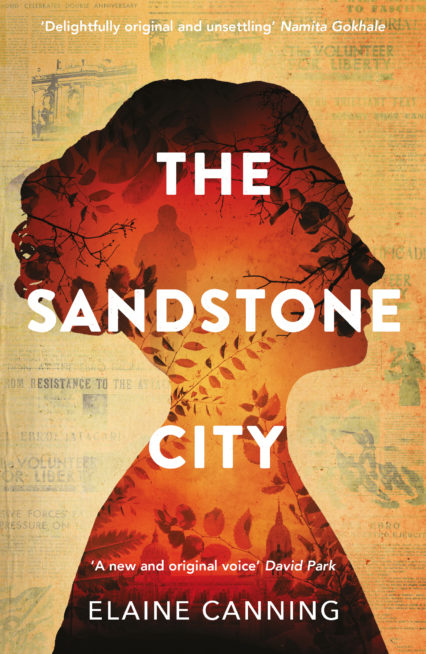Rachel Trezise talks to author Elaine Canning about the publication of her debut novel, The Sandstone City, a haunting tale which explores the story of eighty-eight year-old Michael Doherty, who lies in an open coffin, listening to those who have come to pay their respects.
Rachel Trezise: I realised having read your author note at the end of the novel that part of your inspiration for the story came from your experience as a participant of the Erasmus scheme, (defunct in the UK since the inception of Brexit), having received a grant to study in Salamanca. (This is something we share; I received an Erasmus grant to study in Limerick). How important do you think that opportunity was in shaping this story but also your creative mind more generally?
Elaine Canning: Without a doubt, my experience as an Erasmus student studying at the University of Salamanca has had a profound, long-lasting impact, both in terms of shaping the story of The Sandstone City, and upon me as an individual. I fell in love with the city from the moment I stepped inside the main square, the Plaza Mayor, with its beautiful sandstone façades, balustrades and arches so typical of the rest of the city. But there was much more to Salamanca than its architecture: it’s there that I became fully immersed in a culture and language that I had always loved. I was able to deep dive into it all, rather than admiring it from afar or skating across its surface. It’s also where I first lived independently (I was a live-at-home student while studying in Belfast) and where my confidence and self-awareness really began to develop. That confidence, as well as the wealth of new experiences, have played an intrinsic part in allowing me to be creative through storytelling. I love the unusual and unexpected, how they feature in our everyday lives, and how they might lend themselves to both long and short fiction.
Rachel Trezise: Despite the main plot being about the life and death of eighty-eight-year-old Michael Doherty, the novel is crammed with strong Irish women, from Michael’s wife Annie and her daughters, Mary, Catherine and Chrissie right down to Sarah, (the main protagonist), and her best friend Amy. At one point in the book Sarah resists touching her mother Chrissie in case the contact breaks the older woman’s composure: ‘They were the same, two fully-armoured women, able to take on all sorts but easily shattered by a kind touch.’ This felt very much as though it could have been written about my own Welsh grandmother, aunts and mother. Is there a recognised Irish equivalent of the ‘Welsh Mam’ archetype?
Elaine Canning: The figure of the mother has always been central to Irish culture – there’s the Virgin Mother Mary, as well as Mother Ireland, for example, captured in Patrick Pearse’s poem ‘Mise Éire’. We have the Irish Mammy figure who, like the Welsh Mam, is resilient, holds the family together, and is blessed with a quiet, robust strength. But I hope the strong Irish women in the book are symbolic not just of mothers but of those females who have been at the forefront of Irish history and politics – take the Northern Irish women during the Troubles who were at the front-line on guard duty, rattling bin lids and blowing whistles to alert the resting men, exhausted from the day’s fight. I hope, too, that they represent strong women generally, including in Wales, who throughout history have been endowed with unwavering stoicism and determination.
Rachel Trezise: The Spanish Civil War is not the war I expected to be reading about in a novel by a writer from Belfast. Was the fact that some Irish men fought for Franco whilst others fought against him, well known and discussed in Belfast when you were growing up? You describe the novel as a work of fiction, ‘an imagining of the impact of the war upon a working class Belfast family,’ but it seems entirely conceivable that many families really did suffer the same splintering and estrangement as the fictitious Doherty family.
Elaine Canning: When I began to do my research for the book, what particularly fascinated me was the fact that men from Ireland had gone to fight for both the Nationalist and Republican causes of the Spanish Civil War. Whilst growing up in Belfast and studying Spanish at school and University, I never heard about the men who fought for Franco. Those men were actively encouraged to fight for what was seen as a ‘Holy Crusade’, a struggle between Christianity and Communism, and young men were encouraged to do so by priests and bishops, including while they were at church or having their confessions heard. I therefore wanted to take the national context and situate it within the Doherty family, to explore how external factors, in this case a foreign war, could fracture not only a family unit, but an individual’s own sense of self. The closest I got to this kind of splintering of a community in my research was when I discovered two young men from the same street who went to fight for opposing sides. That is not to say that other families did not suffer like the Dohertys, but the story I tell in The Sandstone City is purely fictional.
encouraged to do so by priests and bishops, including while they were at church or having their confessions heard. I therefore wanted to take the national context and situate it within the Doherty family, to explore how external factors, in this case a foreign war, could fracture not only a family unit, but an individual’s own sense of self. The closest I got to this kind of splintering of a community in my research was when I discovered two young men from the same street who went to fight for opposing sides. That is not to say that other families did not suffer like the Dohertys, but the story I tell in The Sandstone City is purely fictional.
Rachel Trezise: I was really pleased to meet a character from the Rhondda Valley, Morris Williams, a wartime friend to Michael. You said that much of your research about the Spanish Civil War was done at the South Wales Miners’ Library. Is Williams a tribute to this fact? Did you find any other interesting stories there about the war that didn’t make it into the novel?
Elaine Canning: Thanks for picking out Morris; yes, although he is a fictional character, he really is a tribute to the men from Wales who went to fight in Spain. As well as having access to so many wonderful assets at the South Wales Miners’ Library, thanks to the brilliant Sian Williams, head of the library, and her fantastic team, I’d also like to acknowledge the wonderful work of the late Dr Hywel Francis on Wales and the Spanish Civil War.
As part of a future project with Sian Williams, I’ll be working further on the Spanish Civil War collection and those interesting stories you mention, particularly on the personal papers of Welsh volunteers who joined the Republican cause as part of the International Brigade effort.
Rachel Trezise: The novel is both structurally and thematically bold, encompassing duality and resurrection and employing a love story to boot. Did you always know that this story would be your first major work? How long have you been carrying the ideas in your head?
Elaine Canning: I had the broad outline of the story for The Sandstone City for some time, and yes, I hoped it would be my first major work. My initial starting points were the Spanish Civil War, as well as the cities of Belfast and Salamanca, and the broad themes of family and intergenerational relations. But it took a while for me to allow Michael’s voice to settle on the page; that’s a little unusual for me as I normally start with character. His back story was always meant to be there, but not Michael as a character in his own right. However, it was only when I let him in that the various threads of the novel began to come together. The other three ghostly / other worldly characters also came later and became important bridging protagonists between Michael and Sarah. All in all, from the first seeds of the ideas to completion, I carried the story around in my head for about four years.
Rachel Trezise: You also mentioned in your note that the novel was partly inspired by your fascination with the relationship between past and present versions of the self. This seems like quite a difficult concept to convey in fiction which relies somewhat on characters’ demeanors and beliefs remaining consistent, at least until the very end of the story. Yet you found an imaginative method of allowing Michael to edit the letters he wrote as a much younger man in order to clearly track the evolution of his memories. How far along in the writing process did you discover this technique if not at the very beginning?
Elaine Canning: This was one of the most challenging and fun aspects of writing the novel! I wanted to try to find a way, somehow, for various iterations of Michael’s identity to fuse on the page as he confronts a shelved, past version of himself. How I ended up doing this came right at the very end and in discussion with my brilliant publisher and editor, Rebecca F. John.
Rachel Trezise: Outside of your writing you are the Head of Special Projects at Swansea University, executing the Rhys Davies National short story competition and the International Dylan Thomas Prize. What effect, if any, does working with other writers on a daily basis have on your work? Do you have any particular writing routine?
Elaine Canning: It has a very significant effect and one for which I’m hugely grateful. I have the consistent privilege of reading widely across a variety of genres and experiencing a whole range of styles and voices, as well as hearing writers speak about their writing processes and practices. I also love the close editorial work I do as part of the Rhys Davies National Short Story Award and working alongside extremely talented judges for both Prizes I’m involved with. I find it all incredibly inspiring and it certainly makes me think more deeply about my own ideas and potential approaches.
In terms of writing routine, I try very hard to protect an hour or so in the very early morning, when it’s just me and my notepad or laptop. I think of it as a time when I can switch off from the rest of the world, before the everyday responsibilities kick in. Other than that, I try to grasp precious writing moments when I can – I’m forever scribbling in a notebook or making notes in my phone when I’m waiting for something else to start.
Rachel Trezise: Finally, what are you working on next?
Elaine Canning: I have three projects on the go at the moment. I’m currently finishing a volume on Maggie O’Farrell for Bloomsbury’s Contemporary Critical Perspectives Series and I’m working on a final draft of a short story collection on the theme of ‘Incommunicado’. The beginnings of a second novel are bedding down too, and I’m really looking forward to developing the characters and story arc over the next few months.
The Sandstone City by Elaine Canning is out now with Aderyn Press and can be purchased from your local bookshop or from the publisher’s website (£8.99 in paperback).












